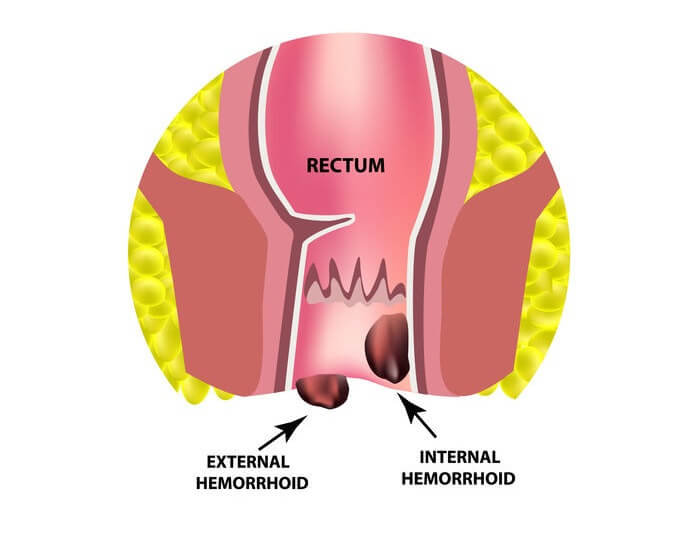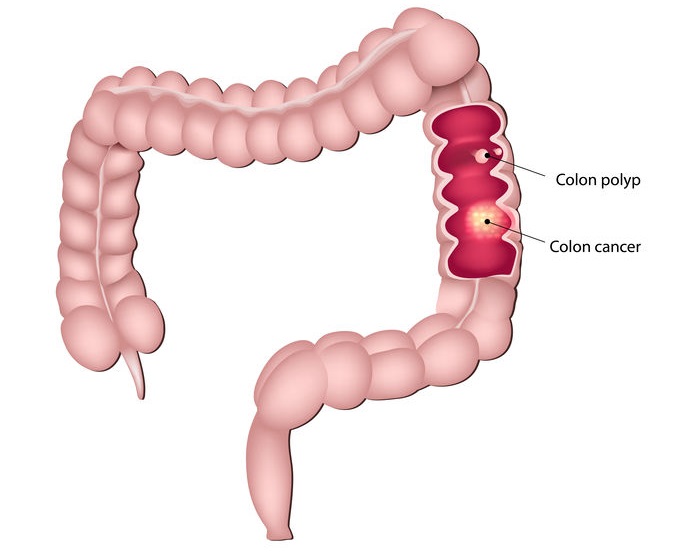Hemorrhoids and colon cancer are two gastrointestinal complications that are on opposite ends of the spectrum. One is a common, curable inflammation; the other is notorious for high mortality rates in the United States. Despite the differences in the nature of the diseases, people often mistake one for the other, which can prove detrimental especially if colon cancer symptoms are treated like hemorrhoid symptoms.
So how is colon cancer different from hemorrhoids? Colon cancer is a fatal cancer that mutates from abnormal polyp growth, while a hemorrhoid is an inconvenient yet temporary inflammation around the rectum area.
Sometimes their symptoms may overlap, but it’s important to understand that hemorrhoid symptoms eventually recede and get better, while colon cancer only further mutates and spreads throughout the body.
What Are Hemorrhoids?
Hemorrhoids are swollen blood veins growing along the lining of the lower part of the rectum and anus. They can either grow internally, above the rectum’s “exit” point, or grow externally where it is visible during an examination.
Although common, the nature of this condition makes patients averse to discussing it openly. Roughly 1 in 20 people are diagnosed with hemorrhoids in the United States. Studies show that about half of adults 50 years of age and older are likely to be diagnosed with hemorrhoids. Pregnant women are also susceptible to hemorrhoids due to changes in the uterus (source).
Cause
There are no definite reasons why hemorrhoids exist. However, doctors believe that straining during a bowel movement, prolonged sitting (especially on the toilet), and constipation can all aggravate symptoms.
Extra pressure on the anal canal can trigger painful inflammations. The muscles along the walls of the rectum can enlarge and swell. When pressure is applied, the blood vessels inside these muscles blow up, causing hemorrhoids to swell with blood.
Here are some factors that could trigger hemorrhoid development:
- A low-fiber diet can cause people to strain during a bowel movement
- Any surgery done on the rectum area can also trigger hemorrhoid growth
- Obesity and a sedentary lifestyle
- Physical activities such as heavy lifting can also cause inflammation
Types of Hemorrhoids

1. Internal Hemorrhoids: This type of hemorrhoid grows inside the rectum and typically grows discreetly unless it gets significantly large. Usually painless, internal hemorrhoids only become apparent because of uncomfortable bowel movement. This type of hemorrhoid may block the stool from passing, which causes blood in the stool.
Internal hemorrhoids can protrude outside the anus. In this case, they become visible and painful because of the active nerves around the rectal area. Protruding internal hemorrhoids typically recede on their own. If not, they can always be nudged back into place. This condition is what is known as a prolapsed hemorrhoid.
2. External Hemorrhoids: External hemorrhoids are growths that occur outside anus. These are not to be confused with a prolapsed or protruding internal hemorrhoid. These are usually situated under the skin, and are attached in areas lower than internal hemorrhoids.
3. Thrombosed Hemorrhoids: When aggravated, hemorrhoids can develop a blood clot, causing them to become tender and painful. This development is called a thrombosed hemorrhoid.
The growth turns into a purple or blue color due to the absence of normal blood flow. Patients report greater discomfort, itching, and sometimes even pain when sitting. Hemorrhoids that no longer receive any blood flow are called strangulated hemorrhoids.
Why Are Older People Likelier to Get Hemorrhoids?
Weaker muscles and a sedentary lifestyle are the two main reasons why older people become more susceptible to hemorrhoids. We recommend even 20 minutes of low intensity exercises such as walking, as well as a high-fiber diet to promote good bowel movement.
What Is Colon Cancer?

Colon cancer (sometimes referred to as colorectal cancer) develops from polyps or growths along the lining of the colon. It is the third most diagnosed cancer in the United States. According to the American Cancer Society, about 1 in 24 women and 1 in 22 men have a lifetime risk of developing colon cancer (source).
Cause
Cells naturally divide, multiply, and die. However, cell behavior can deviate from normal, leading to an increase in their production and growth. This cellular change creates polyps along the inside of the colon. These growths are what mutate further into colon cancer.
Although the main cause for colon cancer is still unknown to scientists, there are risk factors that can increase a person’s chances of developing this type of cancer:
- Colon cancer may not be hereditary, but there are certain inherited genetic syndromes that can increase your risk for colon cancer. This includes the familial adenomatous polyposis (FAP) and hereditary non-polyposis colorectal cancer (HNPCC)
- Age and ethnic background can also contribute to a higher risk of developing this cancer. Adults over the age of 50 and people with Jewish or African-American backgrounds are considered above-average risk individuals
- People consuming diets high in red meat and fat are also at an increased risk. Certain chemicals in food can initiate cell mutation, which promotes polyp growth along the colon. Excessive cigarette and alcohol consumption are considered equally risky
Colon Cancer VS Hemorrhoids: Signs and Symptoms
| Hemorrhoids | Colon Cancer |
| Itching and irritation around the anal area | Cramping or pain in the abdomen |
| Bright red blood on the stool | Dark, tar-like stool |
| Discomfort during bowel movement | Change in bowel habits: diarrhea, constipation that last |
| Pain when sitting or walking due to lumps near the anus | Lingering constipation; needing to have a bowel movement but not being relieved by having one |
| Evident lump/swelling around the anus | Rectal bleeding |
| Unexplained weight loss | |
| In some cases, anemia |
Bleeding in Colon Cancer VS Hemorrhoids
Bleeding is a common symptom of colon cancer and hemorrhoids. When people find blood in their stool, they often immediately assume it’s one or the other since this is a commonly seen symptom.
While true, there are slight differences in the bleeding caused by colon cancer compared to what is caused by hemorrhoids.
It is important to understand that colon cancer and hemorrhoids occur on two different areas of the gastrointestinal tract. Hemorrhoids, both internal and external, grow at the lower part of the tract, just a few inches away from the anus. Colon cancer, on the other hand, is caused by polyps found in the ascending colon (“left colon”) or descending colon (“right polyp”), in the upper part of the tract.
Some anatomical knowledge makes it easier to understand the difference between bleeding caused by either abnormalities.
Hemorrhoid Bleeding
Hemorrhoid-induced bleeding is caused by the stool rubbing against the hemorrhoid as it passes through the rectum. In some cases, the hemorrhoid itself bleeds and may make its way down the rectum.
However, it’s more common for stool to bump against obstructive growth, causing it to rupture and bleed. The bright red blood comes from how “fresh” the wound is. The bright red blood patients report is the stool rubbing against an inflamed hemorrhoid.
Colon Cancer Bleeding
Contrary to popular belief, the presence of blood in the stool is not always a sign of colon cancer. In fact, colon cancer symptoms gradually develop over the course of 10 years, and only ever begin to appear in its later stages.
Colon cancer itself doesn’t cause internal bleeding. The blood in the stool reported by patients is the polyp bleeding after it gains significant mass. Instead of bright red blood, diagnosed colon cancer patients often report dark, tar-like stool.
Blood is rarely visible to the naked eye, which is why it’s impossible to detect cancer just by looking at the stool alone.
Read more: Your Blood Can Tell If You Have Colon Cancer
Are Hemorrhoids a Sign of Cancer?
The symptoms for colon cancer and hemorrhoids sometimes overlap, leading patients to believe their hemorrhoid symptoms are actually indicative of polyp growth in the colon.
Hemorrhoids and colon cancer are two separate abnormalities. As explained, hemorrhoids occur when extra pressure is introduced in the rectum area, whereas polyp growth occurs only along the colon lining.
Can Hemorrhoids Lead to Colon Cancer?
100% of colon cancers evolve from large polyps, which are mutated cells that grow along the colon tract. This means that there is zero chance for any hemorrhoid to lead to colon cancer. Again, hemorrhoids are swollen veins on the muscle of the rectum, not mutated cells along the colon.
Understand what is causing blood in your stool. Get screened today and reach a final diagnosis. Achieve your peace of mind.
